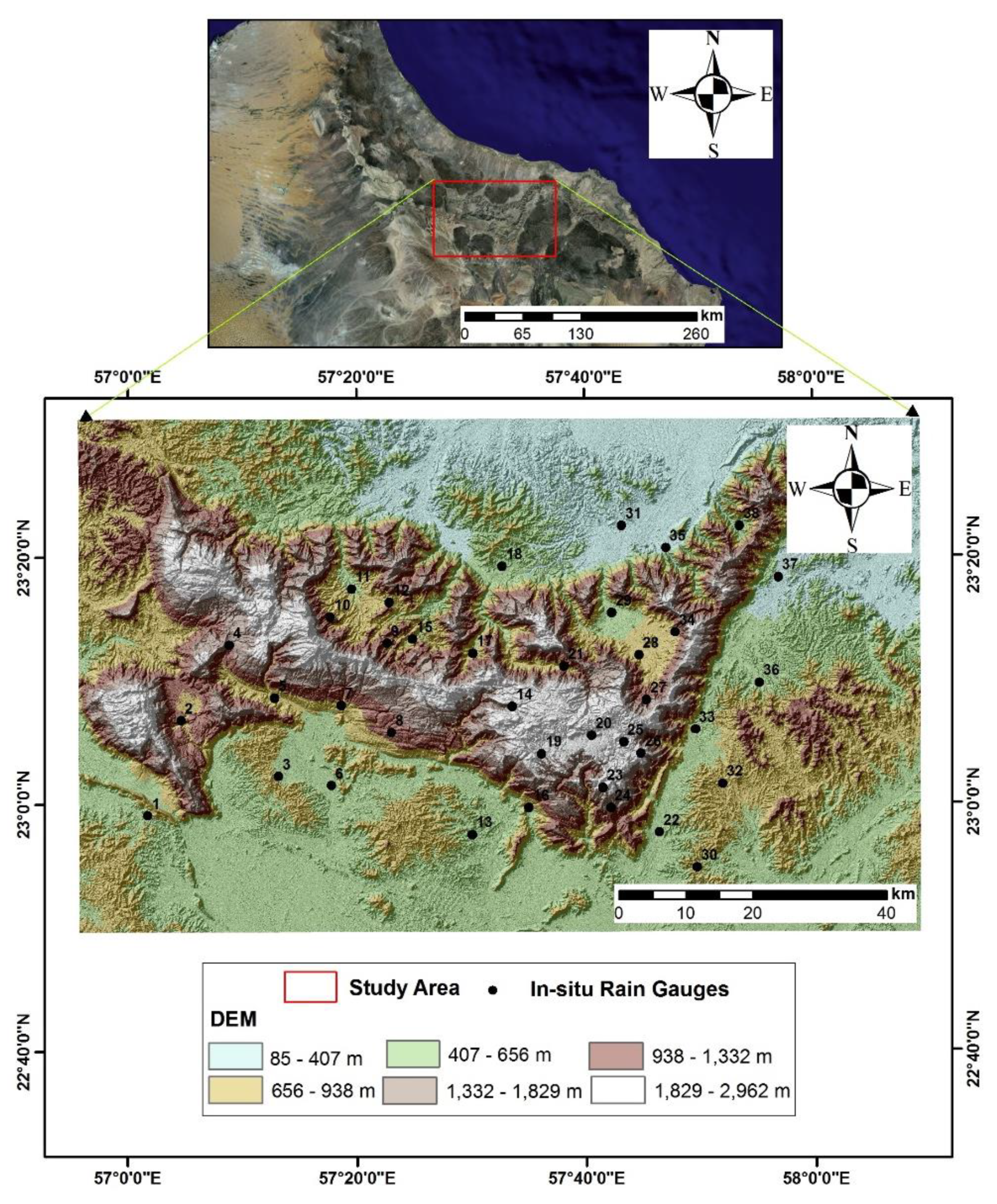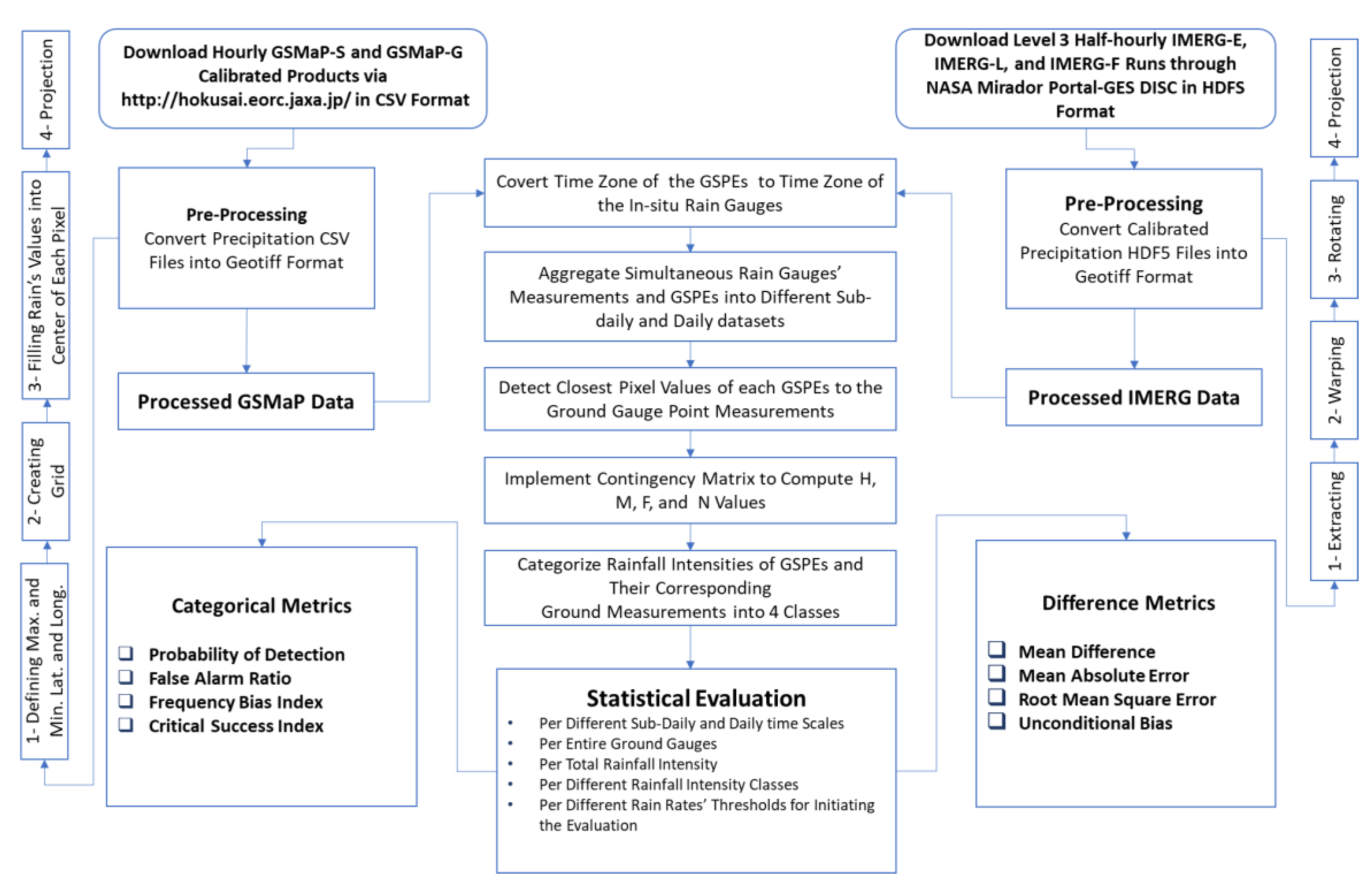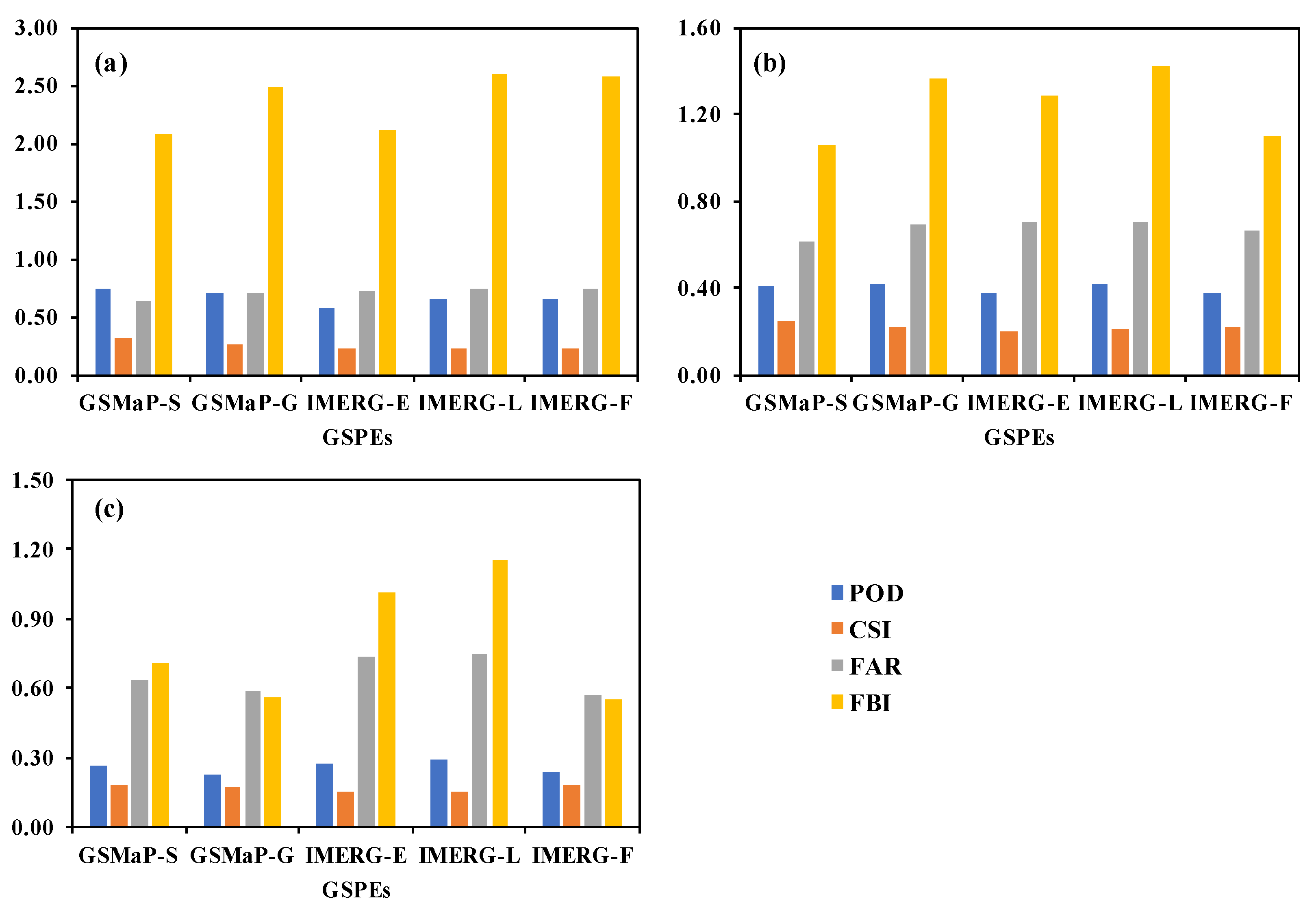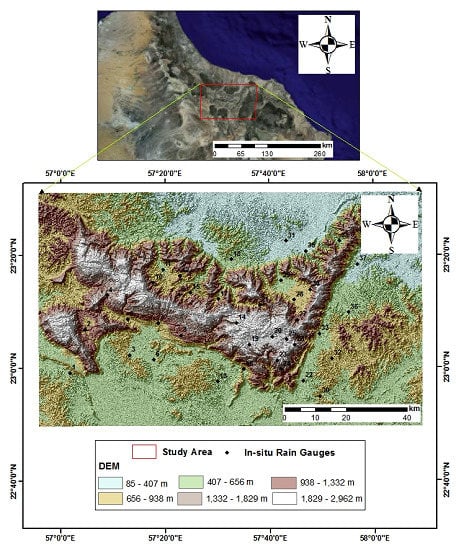1. Introduction
Precipitation is one of the key components of the water cycle that is crucial to study the hydrological balance, water resources management, drought monitoring, flood forecasting, as well as critical social and climatological issues [
1]. However, quantifying precipitation is complicated because it has a non-normal distribution and high variability, even at a small scale [
1,
2]. In general, direct surface rain observations from in-situ gauges and indirect measurements through optical and microwave satellites or weather Radars are the currently available data sources to estimate the precipitation rates. The ground rainfall gauges are used to measure rainfall flux directly and determine its rate in a small area [
3]. They can capture continuous measurements at high temporal frequencies. However, traditional point rain gauges cannot capture the areal representation and variation of rainfall, especially in regions where the in-situ rain gauges are limited in number and coverage [
3]. Even if rain gauge network measurements are interpolated, they yield a uniform rainfall field that does not represent the real spatial and temporal rainfall variability [
4]. Furthermore, the operation of rain gauges is costly, and in most cases, they are sparsely distributed or unavailable in remote areas due to difficulties of access for installation and maintenance [
5]. The latter case has been escalated over the arid Gulf countries. Ground weather Radars can gain information about the internal structure of storms and provide real-time high-resolution monitoring of precipitation over vast areas [
6]. However, they are also unavailable or not dense enough over most regions of the world.
The shortcomings of the previously-mentioned ground-based methods to measure precipitation highlighted the need for the global coverage of the Earth observation satellites [
7]. Over the last few decades, different Global Satellite-based Precipitation Estimates (GSPEs) were made available from multiple international organizations allowing high-quality rainfall monitoring at fine spatial and temporal resolutions. Nowadays, a new generation of GSPEs is being made available to ensure frequent and continuous rainfall monitoring.
The GSPEs are usually used to identify the spatial extent and magnitude of the rainfall events, especially the extreme ones [
8]. Their advantages were outlined by Gebregiorgis and Hossain [
9], such as: (i) overcoming the problem of geopolitical boundaries, (ii) covering continents and oceans, (iii) producing consecutive records at day and night, (iv) introducing a cost-effective way comparing to in-situ networks, and (v) delivering the data in a near-real-time, which would be critical to some applications such as monitoring and forecasting of flash flooding events.
GSPEs involve indirect blended precipitation estimates from Geosynchronous Infrared (GEO-IR)- and Low Earth Orbit-Passive Microwave (LEO-PMW)-based sensors [
10]. The GEO-IR satellite data identifies the cloud-top characteristics that have an indirect relationship with the rainfall rate. Additionally, they cannot record rainfall from warm clouds. The LEO-PMW estimates can be profoundly affected by the ice particles or droplets associated with rainfall. They are less frequent than GEO-IR estimates and have poor spatial resolutions. Furthermore, they encounter significant sampling errors, particularly when comparing to the short-term rainfall measurements. Therefore, blending the LEO-PMW and GEO-IR satellite data to generate the new versions of GSPEs helped to gain improved rainfall estimates.
Weather satellites, despite uncertainties in their estimates, can monitor the rainfall at effective spatial and temporal resolutions. Their effective spatial and temporal coverage allows satellite sensors to generate information at regular intervals [
3,
11,
12,
13]. GSPEs are usually unable to provide estimates that are entirely similar to the gauge measurements in both temporal and spatial scales [
14]. The uncertainties (i.e., non-negligible errors) associated with GSPEs introduce a significant challenge for the end-users to apply these data in practical meteorological and hydrological applications [
15]. Therefore, the nature and magnitude of these errors must be thoroughly evaluated and determined to take better advantage of GSPEs’ products. Quantifying the level of uncertainty in different GSPEs can be helpful for data producers to improve their algorithms and for the end-users to verify the accuracy of these products before utilizing them in a specific application [
9].
Dedicated efforts have been made by different researchers to evaluate the performance of various GSPEs. Many authors have studied different runs of Global Precipitation Mission-based Integrated Multi-satellitE Retrievals (GPM-IMERG) over different climatic zones in many parts of the world. The annual and seasonal average precipitation of daily re-sampled Global Satellite Mapping of Precipitation, i.e., GSMaP V06 (0.25° × 0.25°) product, capture a more accurate spatial rainfall pattern than the IMERG-Final, i.e., IMERG-F V03 and V04 for most regions of China [
16]. Despite the GSMaP-Gauge, i.e., GSMaP-G V07 overestimated light rainfall and underestimated heavy rain, its overall quality still slightly outperformed the IMERG V04 and V05 over east and south China [
17]. Besides, the performance of the calibrated IMERG V05 did not have a significant improvement over that of IMERG V04 [
17].
Milewski et al. [
18] assessed the GPM predecessor, i.e., Tropical Rainfall Measuring Mission (TRMM) Multi-satellite Precipitation Analysis (TMPA products) using a rain gauge network in northern Morocco. They found that TMPA 3B42 V7 was the most spatially consistent with the rain gauge measurements. Additionally, all four products showed overestimations across this arid environment. Monthly GSMaP Moving Vector with Kalman filter, i.e., GSMaP-MVK V06 had slightly superior performance to V06 datasets over Pakistan [
19]. At daily and monthly timescales, the IMERG V04 was considered as the most suitable IMERG version to detect precipitation estimates over the extreme arid region in Pakistan. Furthermore, the daily GSMaP-G V06 had superior performance with respect to IMERG V05 and TMPA V06 in all areas and all precipitation thresholds in Brazil [
20]. Mahmoud et al. [
21] evaluated the daily performance of the early, late, and final GPM-IMERG over entire Saudi Arabia using 1455 measurements from in the Sultanate of Oman. In this study, we evaluated the 189 in-situ rain gauges from October 2015 to April 2016. The early and late IMERG (i.e., IMERG-E and IMERG-L) products performed well in some parts of Saudi Arabia, but the IMERG-F run had better performance than both. Moreover, Mahmoud et al. [
22] evaluated the spatiotemporal performance of three daily GPM-IMERG runs over the entire area of the United Arab Emirates (UAE) (i.e., 83,600 km
2) using 1610 rainy events from January 2015 to December 2017. They interpolated rainy measurements when at least 30 in-situ rain gauge stations had records across the entire UAE on the same day. They mentioned that IMERG-F had the highest agreement with the ground measurements. Utilizing observations from 53 ground gauges from 2003–2010 over the entire UAE, Wehbe et al. [
23] stated that the daily TMPA 3B42 V06 (0.25°) had a higher agreement with gauge measurements than daily Climate Prediction Center MORPHing technique (CMORPH) product (0.25°).
In the Sultanate of Oman (i.e., our proposed study area), water resources are scarce [
24]. The primary source of surface and sub-surface water is the rainfall, and complex mountains (400 m–3000 m above sea level [
25]) act as water towers [
26]. The spatiotemporal performance of GPM and GSMaP estimates has not been studied over arid areas performance of 5 quasi-global GSPEs over an arid environment using in-situ rain gauge measurements as benchmarks. The current paper introduces the first detailed daily and sub-daily assessment of GSPEs over the Arabian Peninsula. With an emphasis on the latency time aspect of these GSPEs, the ultimate objective of this research was to assess their performance per entire ground stations in relationship to different rainfall intensity classes. Because GSPEs have mostly global or quasi-global orientations, the performance of these products is expected to vary from one location to the other. Therefore, it is mandatory to assess the performances of GSPEs using the local in-situ rain gauge datasets before they can be utilized with high confidence in different environmental applications over a specific study area. Such evaluation and inter-comparison can also help to determine the most accurate and appropriate GSPEs among various alternatives.
5. Discussion
The use of the daily in-situ rainfall gauges as benchmarks to evaluate the performance of the GSPEs has been less documented by previous studies over the arid Arabian Peninsula. Over entire Saudi Arabia, Mahmoud et al. [
21] evaluated the three GPM-IMERG runs using 1455 records from 189 in-situ rain gauges during the period October 2015–April 2016. Utilizing the entire ground stations, the reported RMSE and MAD values ranged from 10 mm/day to greater than 40 mm/day. The reported categorical performance metrics such as POD and CSI were greater than 0.6, 0.7, and 0.9 in case of the early, late, and final IMERG products, respectively. The MAE values of the IMERG-E run ranged from 10–25 mm/day, while they showed slight improvement in the case of IMERG-L. The IMERG-F yielded the lowest MAD with values less than 10 mm/day. The reported RMSE values ranged from 10 mm/day to greater than 30 mm/day in the case of IMERG-E, and they provided considerable improvement with reduced RMSE values from 40 mm/day to 20 mm/day over some regions. The IMERG-F mostly yielded RMSE values less than 10 mm/day, with few exceptions at some regions where they reached 30 mm/day. Based on the individual stations, the estimated RMSE, MD, and MAD ranged from 15 mm/day to greater than 55 mm/day, −20 mm/day to greater than 20 mm/day, and 5 mm/day to greater than 40 mm/day, respectively. The reported categorical performance metrics such as POD and CSI values ranged from less than 0.5 to greater than 0.85. The IMERG-F showed a higher accuracy over the other two IMERG runs that had fluctuated performance between over- and under-estimation of the in-situ gauge measurements over the different regions of Saudi Arabia.
In 2019, Mahmoud et al. [
22] evaluated the accuracy of the three GPM-IMERG products utilizing 1600 in-situ measurements recorded from 81 rain gauges from January 2015–December 2017 over the entire area of UAE. The IMERG-F reported the highest accuracy and lowest estimation error compared to other IMERG products. The late run showed a slight improvement over the early product. The regional evaluation of the early, late, and final IMERG products reported POD values that ranged from 0.68–0.8, 0.7–greater than 0.8, and greater than 0.85, respectively. On the basis of evaluating the individual stations, an overall high detection accuracy with POD greater than 0.75 was recorded. Based on the evaluation of the IMERG products using the entire ground stations, the early and late runs showed MAD and RMSE values that generally ranged from 10 mm/day to greater than 15 mm/day, and 15 mm/day to 30 mm/day, respectively. The late run showed a higher estimation error than that observed in the early product with an average increment of 15%. The IMERG-F product reported difference error lower than the other IMERG product with MAD and RMSE values that ranged from 9–11 mm/day and from less than 15–21 mm/day. The individual station-based assessment showed similar results to the regional assessment, but the RMSE reached more than 40 mm/day in some locations.
Nashwan et al. [
46] validated three GSPEs (IMERG-F V05, GSMaP V07, and Climate Hazards Group InfraRed Precipitation with Stations (CHIRPS)) over Egypt during the period from March 2014–May 2018. They used 670 rainfall events recorded by 29 in-situ meteorological stations that collected by the US National Climate Data Center Global Summary of Days (GSOD). Although the three GSPEs are gauge-corrected, they did not show consistent performance. Therefore, no single product can be named as the best/worst performing product in Egypt. Without classifying the rainfall intensity, the CHIRPS ranked first with the lowest estimation error, i.e., median RMSE = 2 mm/day. The median values of RMSE reported by the IMERG-F and GSMaP-G were found to be close to that provided by CHIRPS. For the light rainfall intensity class, the GSMaP-G and CHIRPS generally demonstrated similar median RMSE values, i.e., 1.03 mm/day. The same results were reported from the low-moderate rainfall intensity class, but CHIRPS showed a slightly higher median RMSE value, i.e., 2.82 mm/day, than the GSMaP_G. Furthermore, GSMaP-G recorded also the lowest median RMSE at the heavy rainfall intensity class. The three GSPEs reported weak performance for the heavy rainfall class with the highest median RMSE value, i.e., 51 mm/day. The GSMaP-G and IMERG-F similarly captured the spatial distribution of the rainfall, but the GSMaP-G was more consistent with the in-situ observations than the IMERG-F run. In general, the lack of detailed ground rainfall records may contribute significantly to the unsatisfactory performance of the three GSPEs. The accurate detection of rainfall using the GSPEs over the arid climate, particularly the deserts of hot climate is still challenging and open for further studies. Nashwan et al. [
46] stated that their research was constrained by the lack of dense in-situ rainfall measurements. More daily and sub-daily ground gauge records are needed to evaluate the diurnal rainfall cycles of the IMERG-F and GSMaP-G at fine temporal resolutions.
The findings of Nashwan et al. [
46] were similar to our results at the daily time scale, but the magnitude of the estimated errors was lower in our case study. Additionally, the previous studies showed that the performance of the different GSPEs was inconsistent with respect to the in-situ gauge measurements. Although this fluctuated performance, our findings agreed with the other authors that GSMaP-G mostly provides the best performance. Additionally, the IMERG-F slightly outperformed the IMERG-E and IMERG-L.
Water was, still, and will be the most influential factor in Earth’s evolution [
47]. The need for continuous and long precipitation records of high accuracy and free availability is a frequent problem for the environmental modelers [
48]. Reliable rainfall records constitute integral inputs of different environmental models, particularly flood inundation modeling (e.g., [
49] and their associated watershed (e.g., [
50,
51]), runoff (e.g., [
52]), groundwater flow and recharge (e.g., [
53]), surface and subsurface water pollution (e.g., [
54]), soil moisture (e.g., [
55]), optimum water management (e.g., [
56]), climate prediction and forecasting (e.g., [
57], and hazard assessment (e.g., [
58]) models. The GSPEs introduce an alternative and promising source of continuous rainfall records for different hydrological and environmental applications, particularly over the arid area [
46,
59]. There is no perfect rainfall data, but selecting the optimum datasets depend mainly on the purpose of the given application [
48]. Additionally, choosing precipitation records depend on the method, spatial, and temporal resolutions [
60], which can give the advantage of using GSPEs over the traditional gauge data in various environmental applications.
6. Conclusions
This paper presented a detailed statistical evaluation of 5 GSPEs (GEMaP-S, GSMaP-G, IMERG-E, IMERG-L, and IMERG-F). In general, the performance of the 5 GSPEs enhanced with receiving more spaceborne estimates throughout the day. Both GSMaP products reported the best statistical metrics, among other GSPEs, in most of daily and sub-daily comparisons with the in-situ rain gauge measurements. The IMERG-F slightly outperformed the IMERG-L and IMERG-E. However, the early and late IMERG runs gave promising results, particularly they have shorter latency times (i.e., 4 and 12 h, respectively) and uncorrected with gauge information. The availability of these products within shorter times than the other GSPEs can help in different hydrological applications such as monitoring flash flood over fine sub-daily temporal resolutions. Up to our knowledge, there were no previous studies concerning evaluating different GSPEs at sub-daily time scales over this extremely arid area of the world. The assessment of the 5 GSPEs over daily and sub-daily time intervals revealed the following:
The overall performance of the 5 GSPEs in capturing daily rainfall events of the total intensity class was acceptable in comparison with the results reported from previous literature mentioned above in the discussion section. With respect to the error difference between GSPEs and ground gauge records, the GSMaP-G, IMERG-F, and GSMaP-S showed the lowest recorded RMSE and MAD values. In terms of MD and UB metrics, The IMERG-L ranked first with reporting the lowest underestimation values, and IMERG-E and GSMaP-G came in the second and third places, respectively.
The 5 GSPEs generally underestimated the in-situ rainfall measurements at different rainfall intensity classes, except for the light rainfall of an intensity less than 2.5 mm/day. With respect to the underestimation of moderate to heavy in-situ rainfall records per daily basis, the IMERG-L ranked first with reporting the lowest underestimation values and followed by IMERG-E and GSMaP-S.
The underestimation of ground rainfall measurements per day raised with the increase of the rainfall intensity from less than 2.5 mm/day to greater than 50 mm/day.
At both daily and sub-daily time scales, the lowest RMSE and MAD values were mostly demonstrated by GSMaP-G, IMERG-F, and GSMaP-S, respectively. The only exception was at a rainfall intensity greater than 50 mm/day, where IMERG-E and IMERG-L came in the first two places with reporting the lowest recorded RMSE and MAD values.
The daily performance of the 5 GSPEs at a rainfall intensity greater than 50 mm was very low, where they heavily underestimated the ground rainfall measurements. This weak performance could be interpreted by the minor amount of reported rainfall events (i.e., 14) for the short period of mid-March 2014 to October 2016, as well as the erratic behavior of rain over the arid areas.
For the 5 GSPEs, the POD and CSI values improved, and FAR and FBI measures decreased with the increase of the temporal resolution from 6 to 18 h.
The GSMaP-G showed the lowest underestimation degree of the ground rainfall measurements of accumulated rain intensity per 6 h, while IMERG-L outperformed the other GSPEs per 12 and 18 h.
At a rainfall intensity of less than 2.5 mm per sub-daily time intervals, the GSMaP-G and IMERG-F closely matched with ground rainfall measurements with reporting the lowest MD, MAD, and RMSE values, as well as UB sores close to unity.
Within a rainfall intensity class between 2.5–10 mm/h, GSMaP-G had a good agreement with in-situ rain observations per 6 h, while IMERG-L showed higher matching than the other GSPEs at the time intervals of 12 and 18 h. The GSMaP-G and IMERG-F showed the lowest statistical error differences at the three different temporal resolutions.
At a rainfall intensity of 10–50 mm/h, the estimated MD and UB values were much larger than those estimated at the light and moderate rainfall intensity classes. These values could be interpreted by the possible occurrence of heavy rainfall events that were captured by the in-situ gauges while massively undervalued by the GSPEs.
GSMaP-G had the closest matching with the ground rain measurements at the early night hours (i.e., 00.00 to 06:00 UTC/GMT). With moving toward the daytime (i.e., 06:00 to 12:00 and 12:00 to 18:00 UTC/GMT), IMERG-F showed the best performance with reporting the lowest MD among other GSPEs. Additionally, the reported error differences during early night times were larger than those computed in the day time.
Concerning the accumulated rainfall at a rain threshold of 0.00 mm per different sub-daily time scales, the two GSMaP products kept mostly achieving the top performance on the basis of POD and CSI metrics. GSMaP-S ranked first with reporting lowest FAR and FBI at different time intervals except at 18 h, where it came second after GSMaP-G.
With respect to evaluating light rainfall of an intensity of less than 2.5 mm per sub-daily and daily time intervals, the GSMaP products outperformed IMERG runs based on the 4 categorical measures.
Based on the achieved findings and with the difficulties in having continuous and reliable rainfall records from in-situ gauge networks, we would recommend that the researchers in the arid areas should pay more attention to use and assess the available GSPEs in their hydrological and water management studies.













